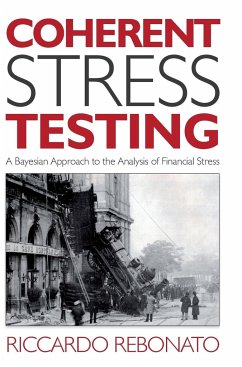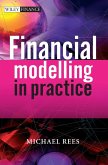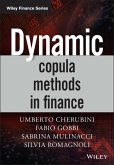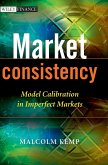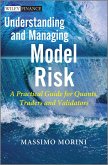Riccardo Rebonato
Coherent Stress Testing
Riccardo Rebonato
Coherent Stress Testing
- Gebundenes Buch
- Merkliste
- Auf die Merkliste
- Bewerten Bewerten
- Teilen
- Produkt teilen
- Produkterinnerung
- Produkterinnerung
In Coherent Stress Testing: A Bayesian Approach, industry expert Riccardo Rebonato presents a groundbreaking new approach to this important but often undervalued part of the risk management toolkit.
Based on the author's extensive work, research and presentations in the area, the book fills a gap in quantitative risk management by introducing a new and very intuitively appealing approach to stress testing based on expert judgement and Bayesian networks. It constitutes a radical departure from the traditional statistical methodologies based on Economic Capital or Extreme-Value-Theory…mehr
Andere Kunden interessierten sich auch für
![Credit Risk Modeling using Excel and VBA Credit Risk Modeling using Excel and VBA]() Gunter LöfflerCredit Risk Modeling using Excel and VBA126,99 €
Gunter LöfflerCredit Risk Modeling using Excel and VBA126,99 €![Stochastic Claims Reserving Methods in Insurance Stochastic Claims Reserving Methods in Insurance]() Mario WuethrichStochastic Claims Reserving Methods in Insurance158,99 €
Mario WuethrichStochastic Claims Reserving Methods in Insurance158,99 €![Financial Modelling in Practice Financial Modelling in Practice]() Michael ReesFinancial Modelling in Practice148,99 €
Michael ReesFinancial Modelling in Practice148,99 €![Dynamic Copula Methods in Finance Dynamic Copula Methods in Finance]() Umberto CherubiniDynamic Copula Methods in Finance142,99 €
Umberto CherubiniDynamic Copula Methods in Finance142,99 €![Fx Options and Smile Risk Fx Options and Smile Risk]() Antonio CastagnaFx Options and Smile Risk95,99 €
Antonio CastagnaFx Options and Smile Risk95,99 €![Market Consistency Market Consistency]() Malcolm KempMarket Consistency92,99 €
Malcolm KempMarket Consistency92,99 €![Understanding and Managing Model Risk Understanding and Managing Model Risk]() Massimo MoriniUnderstanding and Managing Model Risk125,99 €
Massimo MoriniUnderstanding and Managing Model Risk125,99 €-
-
-
In Coherent Stress Testing: A Bayesian Approach, industry expert Riccardo Rebonato presents a groundbreaking new approach to this important but often undervalued part of the risk management toolkit.
Based on the author's extensive work, research and presentations in the area, the book fills a gap in quantitative risk management by introducing a new and very intuitively appealing approach to stress testing based on expert judgement and Bayesian networks. It constitutes a radical departure from the traditional statistical methodologies based on Economic Capital or Extreme-Value-Theory approaches.
The book is split into four parts. Part I looks at stress testing and at its role in modern risk management. It discusses the distinctions between risk and uncertainty, the different types of probability that are used in risk management today and for which tasks they are best used. Stress testing is positioned as a bridge between the statistical areas where VaR can be effective and the domain of total Keynesian uncertainty. Part II lays down the quantitative foundations for the concepts described in the rest of the book. Part III takes readers through the application of the tools discussed in part II, and introduces two different systematic approaches to obtaining a coherent stress testing output that can satisfy the needs of industry users and regulators. In part IV the author addresses more practical questions such as embedding the suggestions of the book into a viable governance structure.
Hinweis: Dieser Artikel kann nur an eine deutsche Lieferadresse ausgeliefert werden.
Based on the author's extensive work, research and presentations in the area, the book fills a gap in quantitative risk management by introducing a new and very intuitively appealing approach to stress testing based on expert judgement and Bayesian networks. It constitutes a radical departure from the traditional statistical methodologies based on Economic Capital or Extreme-Value-Theory approaches.
The book is split into four parts. Part I looks at stress testing and at its role in modern risk management. It discusses the distinctions between risk and uncertainty, the different types of probability that are used in risk management today and for which tasks they are best used. Stress testing is positioned as a bridge between the statistical areas where VaR can be effective and the domain of total Keynesian uncertainty. Part II lays down the quantitative foundations for the concepts described in the rest of the book. Part III takes readers through the application of the tools discussed in part II, and introduces two different systematic approaches to obtaining a coherent stress testing output that can satisfy the needs of industry users and regulators. In part IV the author addresses more practical questions such as embedding the suggestions of the book into a viable governance structure.
Hinweis: Dieser Artikel kann nur an eine deutsche Lieferadresse ausgeliefert werden.
Produktdetails
- Produktdetails
- Wiley Finance Series
- Verlag: Wiley & Sons
- 1. Auflage
- Seitenzahl: 240
- Erscheinungstermin: 13. Juli 2010
- Englisch
- Abmessung: 250mm x 175mm x 18mm
- Gewicht: 582g
- ISBN-13: 9780470666012
- ISBN-10: 0470666013
- Artikelnr.: 29747959
- Herstellerkennzeichnung
- Libri GmbH
- Europaallee 1
- 36244 Bad Hersfeld
- gpsr@libri.de
- Wiley Finance Series
- Verlag: Wiley & Sons
- 1. Auflage
- Seitenzahl: 240
- Erscheinungstermin: 13. Juli 2010
- Englisch
- Abmessung: 250mm x 175mm x 18mm
- Gewicht: 582g
- ISBN-13: 9780470666012
- ISBN-10: 0470666013
- Artikelnr.: 29747959
- Herstellerkennzeichnung
- Libri GmbH
- Europaallee 1
- 36244 Bad Hersfeld
- gpsr@libri.de
DR. RICCARDO REBONATO (London, UK) is Head of Front Office Risk Management and Head of the Clients Analytics team at BGM RBS. He is visiting lecturer at Oxford University (Mathematical Finance) and adjunct professor at Imperial College (Tanaka Business School). He sits on the Board of Directors of ISDA and on the Board of Trustees for GARP. He is an editor for the International Journal of Theoretical and Applied Finance, Applied Mathematical Finance, Journal of Risk, and the Journal of Risk Management in Financial Institutions. He holds doctorates in Nuclear Engineering and in Science of Material/Solid State Phsyics. He was a research fellow in Physics at Corpus Christi College, Oxford, UK.
Acknowledgements.
1 Introduction.
1.1 Why We Need Stress Testing.
1.2 Plan of the Book.
1.3 Suggestions for Further Reading.
I Data, Models and Reality.
2 Risk and Uncertainty - or, Why Stress Testing is Not Enough.
2.1 The Limits of Quantitative Risk Analysis.
2.2 Risk or Uncertainty?
2.3 Suggested Reading.
3 The Role of Models in Risk Management and Stress Testing.
3.1 How Did We Get Here?
3.2 Statement of the Two Theses of this Chapter.
3.3 Defence of the First Thesis (Centrality of Models).
3.3.1 Models as Indispensable Interpretative Tools.
3.3.2 The Plurality-of-Models View.
3.4 Defence of the Second Thesis (Coordination).
3.4.1 Traders as Agents.
3.4.2 Agency Brings About Coordination.
3.4.3 From Coordination to Positive Feedback.
3.5 The Role of Stress and Scenario Analysis.
3.6 Suggestions for Further Reading.
4 What Kind of Probability Do We Need in Risk Management?
4.1 Frequentist versus Subjective Probability.
4.2 Tail Co-dependence.
4.3 From Structural Models to Co-dependence.
4.4 Association or Causation?
4.5 Suggestions for Further Reading.
II The Probabilistic Tools and Concepts.
5 Probability with Boolean Variables I: Marginal and Conditional
Probabilities.
5.1 The Set-up and What We are Trying to Achieve.
5.2 (Marginal) Probabilities.
5.3 Deterministic Causal Relationship.
5.4 Conditional Probabilities.
5.5 Time Ordering and Causation.
5.6 An Important Consequence: Bayes' Theorem.
5.7 Independence.
5.8 Two Worked-Out Examples.
5.8.1 Dangerous Running.
5.8.2 Rare and Even More Dangerous Diseases.
5.9 Marginal and Conditional Probabilities: A Very Important Link.
5.10 Interpreting and Generalizing the Factors x k/i.
5.11 Conditional Probability Maps.
6 Probability with Boolean Variables II: Joint Probabilities.
6.1 Conditioning on More Than One Event.
6.2 Joint Probabilities.
6.3 A Remark on Notation.
6.4 From the Joint to the Marginal and the Conditional Probabilities.
6.5 From the Joint Distribution to Event Correlation.
6.6 From the Conditional and Marginal to the Joint Probabilities?
6.7 Putting Independence to Work.
6.8 Conditional Independence.
6.9 Obtaining Joint Probabilities with Conditional Independence.
6.10 At a Glance.
6.11 Summary.
6.12 Suggestions for Further Reading.
7 Creating Probability Bounds.
7.1 The Lay of the Land.
7.2 Bounds on Joint Probabilities.
7.3 How Tight are these Bounds in Practice?
8 Bayesian Nets I: An Introduction.
8.1 Bayesian Nets: An Informal Definition.
8.2 Defining the Structure of Bayesian Nets.
8.3 More About Conditional Independence.
8.4 What Goes in the Conditional Probability Tables?
8.5 Useful Relationships.
8.6 A Worked-Out Example.
8.7 A Systematic Approach.
8.8 What Can We Do with Bayesian Nets?
8.8.1 Unravelling the Causal Structure.
8.8.2 Estimating the Joint Probabilities.
8.9 Suggestions for Further Reading.
9 Bayesian Nets II: Constructing Probability Tables.
9.1 Statement of the Problem.
9.2 Marginal Probabilities - First Approach.
9.2.1 Starting from a Fixed Probability.
9.2.2 Starting from a Fixed Magnitude of the Move.
9.3 Marginal Probabilities - Second Approach.
9.4 Handling Events of Different Probability.
9.5 Conditional Probabilities: A Reasonable Starting Point.
9.6 Conditional Probabilities: Checks and Constraints.
9.6.1 Necessary Conditions.
9.6.2 Triplet Conditions.
9.6.3 Independence.
9.6.4 Deterministic Causation.
9.6.5 Incompatibility of Events.
9.7 Internal Compatibility of Conditional Probabilities: The Need for a
Systematic Approach.
III Applications.
10 Obtaining a Coherent Solution I: Linear Programming.
10.1 Plan of the Work Ahead.
10.2 Coherent Solution with Conditional Probabilities Only.
10.3 The Methodology in Practice: First Pass.
10.4 The CPU Cost of the Approach.
10.5 Illustration of the Linear Programming Technique.
10.6 What Can We Do with this Information?
10.6.1 Extracting Information with Conditional Probabilities Only.
10.6.2 Extracting Information with Conditional and Marginal Probabilities.
11 Obtaining a Coherent Solution II: Bayesian Nets.
11.1 Solution with Marginal and n-conditioned Probabilities.
11.1.1 Generalizing the Results.
11.2 An 'Automatic' Prescription to Build Joint Probabilities.
11.3 What Can We Do with this Information?
11.3.1 Risk-Adjusting Returns.
IV Making It Work In Practice.
12 Overcoming Our Cognitive Biases.
12.1 Cognitive Shortcomings and Bounded Rationality.
12.1.1 How Pervasive are Cognitive Shortcomings?
12.1.2 The Social Context.
12.1.3 Adaptiveness.
12.2 Representativeness.
12.3 Quantification of the Representativeness Bias.
12.4 Causal/Diagnostic and Positive/Negative Biases.
12.5 Conclusions.
12.6 Suggestions for Further Reading.
13 Selecting and Combining Stress Scenarios.
13.1 Bottom Up or Top Down?
13.2 Relative Strengths and Weaknesses of the Two Approaches.
13.3 Possible Approaches to a Top-Down Analysis.
13.4 Sanity Checks.
13.5 How to Combine Stresses - Handling the Dimensionality Curse.
13.6 Combining the Macro and Bottom-Up Approaches.
14 Governance.
14.1 The Institutional Aspects of Stress Testing.
14.1.1 Transparency and Ease of Use.
14.1.2 Challenge by Non-specialists.
14.1.3 Checks for Completeness.
14.1.4 Interactions among Different Specialists.
14.1.5 Auditability of the Process and of the Results.
14.2 Lines of Criticism.
14.2.1 The Role of Subjective Inputs.
14.2.2 The Complexity of the Stress-testing Process.
Appendix A Simple Introduction to Linear Programming.
A.1 Plan of the Appendix.
A.2 Linear Programming - A Refresher.
A.3 The Simplex Method.
References.
Index.
1 Introduction.
1.1 Why We Need Stress Testing.
1.2 Plan of the Book.
1.3 Suggestions for Further Reading.
I Data, Models and Reality.
2 Risk and Uncertainty - or, Why Stress Testing is Not Enough.
2.1 The Limits of Quantitative Risk Analysis.
2.2 Risk or Uncertainty?
2.3 Suggested Reading.
3 The Role of Models in Risk Management and Stress Testing.
3.1 How Did We Get Here?
3.2 Statement of the Two Theses of this Chapter.
3.3 Defence of the First Thesis (Centrality of Models).
3.3.1 Models as Indispensable Interpretative Tools.
3.3.2 The Plurality-of-Models View.
3.4 Defence of the Second Thesis (Coordination).
3.4.1 Traders as Agents.
3.4.2 Agency Brings About Coordination.
3.4.3 From Coordination to Positive Feedback.
3.5 The Role of Stress and Scenario Analysis.
3.6 Suggestions for Further Reading.
4 What Kind of Probability Do We Need in Risk Management?
4.1 Frequentist versus Subjective Probability.
4.2 Tail Co-dependence.
4.3 From Structural Models to Co-dependence.
4.4 Association or Causation?
4.5 Suggestions for Further Reading.
II The Probabilistic Tools and Concepts.
5 Probability with Boolean Variables I: Marginal and Conditional
Probabilities.
5.1 The Set-up and What We are Trying to Achieve.
5.2 (Marginal) Probabilities.
5.3 Deterministic Causal Relationship.
5.4 Conditional Probabilities.
5.5 Time Ordering and Causation.
5.6 An Important Consequence: Bayes' Theorem.
5.7 Independence.
5.8 Two Worked-Out Examples.
5.8.1 Dangerous Running.
5.8.2 Rare and Even More Dangerous Diseases.
5.9 Marginal and Conditional Probabilities: A Very Important Link.
5.10 Interpreting and Generalizing the Factors x k/i.
5.11 Conditional Probability Maps.
6 Probability with Boolean Variables II: Joint Probabilities.
6.1 Conditioning on More Than One Event.
6.2 Joint Probabilities.
6.3 A Remark on Notation.
6.4 From the Joint to the Marginal and the Conditional Probabilities.
6.5 From the Joint Distribution to Event Correlation.
6.6 From the Conditional and Marginal to the Joint Probabilities?
6.7 Putting Independence to Work.
6.8 Conditional Independence.
6.9 Obtaining Joint Probabilities with Conditional Independence.
6.10 At a Glance.
6.11 Summary.
6.12 Suggestions for Further Reading.
7 Creating Probability Bounds.
7.1 The Lay of the Land.
7.2 Bounds on Joint Probabilities.
7.3 How Tight are these Bounds in Practice?
8 Bayesian Nets I: An Introduction.
8.1 Bayesian Nets: An Informal Definition.
8.2 Defining the Structure of Bayesian Nets.
8.3 More About Conditional Independence.
8.4 What Goes in the Conditional Probability Tables?
8.5 Useful Relationships.
8.6 A Worked-Out Example.
8.7 A Systematic Approach.
8.8 What Can We Do with Bayesian Nets?
8.8.1 Unravelling the Causal Structure.
8.8.2 Estimating the Joint Probabilities.
8.9 Suggestions for Further Reading.
9 Bayesian Nets II: Constructing Probability Tables.
9.1 Statement of the Problem.
9.2 Marginal Probabilities - First Approach.
9.2.1 Starting from a Fixed Probability.
9.2.2 Starting from a Fixed Magnitude of the Move.
9.3 Marginal Probabilities - Second Approach.
9.4 Handling Events of Different Probability.
9.5 Conditional Probabilities: A Reasonable Starting Point.
9.6 Conditional Probabilities: Checks and Constraints.
9.6.1 Necessary Conditions.
9.6.2 Triplet Conditions.
9.6.3 Independence.
9.6.4 Deterministic Causation.
9.6.5 Incompatibility of Events.
9.7 Internal Compatibility of Conditional Probabilities: The Need for a
Systematic Approach.
III Applications.
10 Obtaining a Coherent Solution I: Linear Programming.
10.1 Plan of the Work Ahead.
10.2 Coherent Solution with Conditional Probabilities Only.
10.3 The Methodology in Practice: First Pass.
10.4 The CPU Cost of the Approach.
10.5 Illustration of the Linear Programming Technique.
10.6 What Can We Do with this Information?
10.6.1 Extracting Information with Conditional Probabilities Only.
10.6.2 Extracting Information with Conditional and Marginal Probabilities.
11 Obtaining a Coherent Solution II: Bayesian Nets.
11.1 Solution with Marginal and n-conditioned Probabilities.
11.1.1 Generalizing the Results.
11.2 An 'Automatic' Prescription to Build Joint Probabilities.
11.3 What Can We Do with this Information?
11.3.1 Risk-Adjusting Returns.
IV Making It Work In Practice.
12 Overcoming Our Cognitive Biases.
12.1 Cognitive Shortcomings and Bounded Rationality.
12.1.1 How Pervasive are Cognitive Shortcomings?
12.1.2 The Social Context.
12.1.3 Adaptiveness.
12.2 Representativeness.
12.3 Quantification of the Representativeness Bias.
12.4 Causal/Diagnostic and Positive/Negative Biases.
12.5 Conclusions.
12.6 Suggestions for Further Reading.
13 Selecting and Combining Stress Scenarios.
13.1 Bottom Up or Top Down?
13.2 Relative Strengths and Weaknesses of the Two Approaches.
13.3 Possible Approaches to a Top-Down Analysis.
13.4 Sanity Checks.
13.5 How to Combine Stresses - Handling the Dimensionality Curse.
13.6 Combining the Macro and Bottom-Up Approaches.
14 Governance.
14.1 The Institutional Aspects of Stress Testing.
14.1.1 Transparency and Ease of Use.
14.1.2 Challenge by Non-specialists.
14.1.3 Checks for Completeness.
14.1.4 Interactions among Different Specialists.
14.1.5 Auditability of the Process and of the Results.
14.2 Lines of Criticism.
14.2.1 The Role of Subjective Inputs.
14.2.2 The Complexity of the Stress-testing Process.
Appendix A Simple Introduction to Linear Programming.
A.1 Plan of the Appendix.
A.2 Linear Programming - A Refresher.
A.3 The Simplex Method.
References.
Index.
Acknowledgements.
1 Introduction.
1.1 Why We Need Stress Testing.
1.2 Plan of the Book.
1.3 Suggestions for Further Reading.
I Data, Models and Reality.
2 Risk and Uncertainty - or, Why Stress Testing is Not Enough.
2.1 The Limits of Quantitative Risk Analysis.
2.2 Risk or Uncertainty?
2.3 Suggested Reading.
3 The Role of Models in Risk Management and Stress Testing.
3.1 How Did We Get Here?
3.2 Statement of the Two Theses of this Chapter.
3.3 Defence of the First Thesis (Centrality of Models).
3.3.1 Models as Indispensable Interpretative Tools.
3.3.2 The Plurality-of-Models View.
3.4 Defence of the Second Thesis (Coordination).
3.4.1 Traders as Agents.
3.4.2 Agency Brings About Coordination.
3.4.3 From Coordination to Positive Feedback.
3.5 The Role of Stress and Scenario Analysis.
3.6 Suggestions for Further Reading.
4 What Kind of Probability Do We Need in Risk Management?
4.1 Frequentist versus Subjective Probability.
4.2 Tail Co-dependence.
4.3 From Structural Models to Co-dependence.
4.4 Association or Causation?
4.5 Suggestions for Further Reading.
II The Probabilistic Tools and Concepts.
5 Probability with Boolean Variables I: Marginal and Conditional
Probabilities.
5.1 The Set-up and What We are Trying to Achieve.
5.2 (Marginal) Probabilities.
5.3 Deterministic Causal Relationship.
5.4 Conditional Probabilities.
5.5 Time Ordering and Causation.
5.6 An Important Consequence: Bayes' Theorem.
5.7 Independence.
5.8 Two Worked-Out Examples.
5.8.1 Dangerous Running.
5.8.2 Rare and Even More Dangerous Diseases.
5.9 Marginal and Conditional Probabilities: A Very Important Link.
5.10 Interpreting and Generalizing the Factors x k/i.
5.11 Conditional Probability Maps.
6 Probability with Boolean Variables II: Joint Probabilities.
6.1 Conditioning on More Than One Event.
6.2 Joint Probabilities.
6.3 A Remark on Notation.
6.4 From the Joint to the Marginal and the Conditional Probabilities.
6.5 From the Joint Distribution to Event Correlation.
6.6 From the Conditional and Marginal to the Joint Probabilities?
6.7 Putting Independence to Work.
6.8 Conditional Independence.
6.9 Obtaining Joint Probabilities with Conditional Independence.
6.10 At a Glance.
6.11 Summary.
6.12 Suggestions for Further Reading.
7 Creating Probability Bounds.
7.1 The Lay of the Land.
7.2 Bounds on Joint Probabilities.
7.3 How Tight are these Bounds in Practice?
8 Bayesian Nets I: An Introduction.
8.1 Bayesian Nets: An Informal Definition.
8.2 Defining the Structure of Bayesian Nets.
8.3 More About Conditional Independence.
8.4 What Goes in the Conditional Probability Tables?
8.5 Useful Relationships.
8.6 A Worked-Out Example.
8.7 A Systematic Approach.
8.8 What Can We Do with Bayesian Nets?
8.8.1 Unravelling the Causal Structure.
8.8.2 Estimating the Joint Probabilities.
8.9 Suggestions for Further Reading.
9 Bayesian Nets II: Constructing Probability Tables.
9.1 Statement of the Problem.
9.2 Marginal Probabilities - First Approach.
9.2.1 Starting from a Fixed Probability.
9.2.2 Starting from a Fixed Magnitude of the Move.
9.3 Marginal Probabilities - Second Approach.
9.4 Handling Events of Different Probability.
9.5 Conditional Probabilities: A Reasonable Starting Point.
9.6 Conditional Probabilities: Checks and Constraints.
9.6.1 Necessary Conditions.
9.6.2 Triplet Conditions.
9.6.3 Independence.
9.6.4 Deterministic Causation.
9.6.5 Incompatibility of Events.
9.7 Internal Compatibility of Conditional Probabilities: The Need for a
Systematic Approach.
III Applications.
10 Obtaining a Coherent Solution I: Linear Programming.
10.1 Plan of the Work Ahead.
10.2 Coherent Solution with Conditional Probabilities Only.
10.3 The Methodology in Practice: First Pass.
10.4 The CPU Cost of the Approach.
10.5 Illustration of the Linear Programming Technique.
10.6 What Can We Do with this Information?
10.6.1 Extracting Information with Conditional Probabilities Only.
10.6.2 Extracting Information with Conditional and Marginal Probabilities.
11 Obtaining a Coherent Solution II: Bayesian Nets.
11.1 Solution with Marginal and n-conditioned Probabilities.
11.1.1 Generalizing the Results.
11.2 An 'Automatic' Prescription to Build Joint Probabilities.
11.3 What Can We Do with this Information?
11.3.1 Risk-Adjusting Returns.
IV Making It Work In Practice.
12 Overcoming Our Cognitive Biases.
12.1 Cognitive Shortcomings and Bounded Rationality.
12.1.1 How Pervasive are Cognitive Shortcomings?
12.1.2 The Social Context.
12.1.3 Adaptiveness.
12.2 Representativeness.
12.3 Quantification of the Representativeness Bias.
12.4 Causal/Diagnostic and Positive/Negative Biases.
12.5 Conclusions.
12.6 Suggestions for Further Reading.
13 Selecting and Combining Stress Scenarios.
13.1 Bottom Up or Top Down?
13.2 Relative Strengths and Weaknesses of the Two Approaches.
13.3 Possible Approaches to a Top-Down Analysis.
13.4 Sanity Checks.
13.5 How to Combine Stresses - Handling the Dimensionality Curse.
13.6 Combining the Macro and Bottom-Up Approaches.
14 Governance.
14.1 The Institutional Aspects of Stress Testing.
14.1.1 Transparency and Ease of Use.
14.1.2 Challenge by Non-specialists.
14.1.3 Checks for Completeness.
14.1.4 Interactions among Different Specialists.
14.1.5 Auditability of the Process and of the Results.
14.2 Lines of Criticism.
14.2.1 The Role of Subjective Inputs.
14.2.2 The Complexity of the Stress-testing Process.
Appendix A Simple Introduction to Linear Programming.
A.1 Plan of the Appendix.
A.2 Linear Programming - A Refresher.
A.3 The Simplex Method.
References.
Index.
1 Introduction.
1.1 Why We Need Stress Testing.
1.2 Plan of the Book.
1.3 Suggestions for Further Reading.
I Data, Models and Reality.
2 Risk and Uncertainty - or, Why Stress Testing is Not Enough.
2.1 The Limits of Quantitative Risk Analysis.
2.2 Risk or Uncertainty?
2.3 Suggested Reading.
3 The Role of Models in Risk Management and Stress Testing.
3.1 How Did We Get Here?
3.2 Statement of the Two Theses of this Chapter.
3.3 Defence of the First Thesis (Centrality of Models).
3.3.1 Models as Indispensable Interpretative Tools.
3.3.2 The Plurality-of-Models View.
3.4 Defence of the Second Thesis (Coordination).
3.4.1 Traders as Agents.
3.4.2 Agency Brings About Coordination.
3.4.3 From Coordination to Positive Feedback.
3.5 The Role of Stress and Scenario Analysis.
3.6 Suggestions for Further Reading.
4 What Kind of Probability Do We Need in Risk Management?
4.1 Frequentist versus Subjective Probability.
4.2 Tail Co-dependence.
4.3 From Structural Models to Co-dependence.
4.4 Association or Causation?
4.5 Suggestions for Further Reading.
II The Probabilistic Tools and Concepts.
5 Probability with Boolean Variables I: Marginal and Conditional
Probabilities.
5.1 The Set-up and What We are Trying to Achieve.
5.2 (Marginal) Probabilities.
5.3 Deterministic Causal Relationship.
5.4 Conditional Probabilities.
5.5 Time Ordering and Causation.
5.6 An Important Consequence: Bayes' Theorem.
5.7 Independence.
5.8 Two Worked-Out Examples.
5.8.1 Dangerous Running.
5.8.2 Rare and Even More Dangerous Diseases.
5.9 Marginal and Conditional Probabilities: A Very Important Link.
5.10 Interpreting and Generalizing the Factors x k/i.
5.11 Conditional Probability Maps.
6 Probability with Boolean Variables II: Joint Probabilities.
6.1 Conditioning on More Than One Event.
6.2 Joint Probabilities.
6.3 A Remark on Notation.
6.4 From the Joint to the Marginal and the Conditional Probabilities.
6.5 From the Joint Distribution to Event Correlation.
6.6 From the Conditional and Marginal to the Joint Probabilities?
6.7 Putting Independence to Work.
6.8 Conditional Independence.
6.9 Obtaining Joint Probabilities with Conditional Independence.
6.10 At a Glance.
6.11 Summary.
6.12 Suggestions for Further Reading.
7 Creating Probability Bounds.
7.1 The Lay of the Land.
7.2 Bounds on Joint Probabilities.
7.3 How Tight are these Bounds in Practice?
8 Bayesian Nets I: An Introduction.
8.1 Bayesian Nets: An Informal Definition.
8.2 Defining the Structure of Bayesian Nets.
8.3 More About Conditional Independence.
8.4 What Goes in the Conditional Probability Tables?
8.5 Useful Relationships.
8.6 A Worked-Out Example.
8.7 A Systematic Approach.
8.8 What Can We Do with Bayesian Nets?
8.8.1 Unravelling the Causal Structure.
8.8.2 Estimating the Joint Probabilities.
8.9 Suggestions for Further Reading.
9 Bayesian Nets II: Constructing Probability Tables.
9.1 Statement of the Problem.
9.2 Marginal Probabilities - First Approach.
9.2.1 Starting from a Fixed Probability.
9.2.2 Starting from a Fixed Magnitude of the Move.
9.3 Marginal Probabilities - Second Approach.
9.4 Handling Events of Different Probability.
9.5 Conditional Probabilities: A Reasonable Starting Point.
9.6 Conditional Probabilities: Checks and Constraints.
9.6.1 Necessary Conditions.
9.6.2 Triplet Conditions.
9.6.3 Independence.
9.6.4 Deterministic Causation.
9.6.5 Incompatibility of Events.
9.7 Internal Compatibility of Conditional Probabilities: The Need for a
Systematic Approach.
III Applications.
10 Obtaining a Coherent Solution I: Linear Programming.
10.1 Plan of the Work Ahead.
10.2 Coherent Solution with Conditional Probabilities Only.
10.3 The Methodology in Practice: First Pass.
10.4 The CPU Cost of the Approach.
10.5 Illustration of the Linear Programming Technique.
10.6 What Can We Do with this Information?
10.6.1 Extracting Information with Conditional Probabilities Only.
10.6.2 Extracting Information with Conditional and Marginal Probabilities.
11 Obtaining a Coherent Solution II: Bayesian Nets.
11.1 Solution with Marginal and n-conditioned Probabilities.
11.1.1 Generalizing the Results.
11.2 An 'Automatic' Prescription to Build Joint Probabilities.
11.3 What Can We Do with this Information?
11.3.1 Risk-Adjusting Returns.
IV Making It Work In Practice.
12 Overcoming Our Cognitive Biases.
12.1 Cognitive Shortcomings and Bounded Rationality.
12.1.1 How Pervasive are Cognitive Shortcomings?
12.1.2 The Social Context.
12.1.3 Adaptiveness.
12.2 Representativeness.
12.3 Quantification of the Representativeness Bias.
12.4 Causal/Diagnostic and Positive/Negative Biases.
12.5 Conclusions.
12.6 Suggestions for Further Reading.
13 Selecting and Combining Stress Scenarios.
13.1 Bottom Up or Top Down?
13.2 Relative Strengths and Weaknesses of the Two Approaches.
13.3 Possible Approaches to a Top-Down Analysis.
13.4 Sanity Checks.
13.5 How to Combine Stresses - Handling the Dimensionality Curse.
13.6 Combining the Macro and Bottom-Up Approaches.
14 Governance.
14.1 The Institutional Aspects of Stress Testing.
14.1.1 Transparency and Ease of Use.
14.1.2 Challenge by Non-specialists.
14.1.3 Checks for Completeness.
14.1.4 Interactions among Different Specialists.
14.1.5 Auditability of the Process and of the Results.
14.2 Lines of Criticism.
14.2.1 The Role of Subjective Inputs.
14.2.2 The Complexity of the Stress-testing Process.
Appendix A Simple Introduction to Linear Programming.
A.1 Plan of the Appendix.
A.2 Linear Programming - A Refresher.
A.3 The Simplex Method.
References.
Index.

